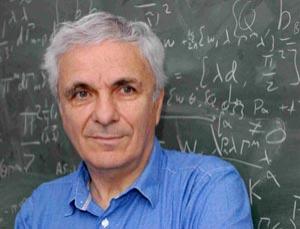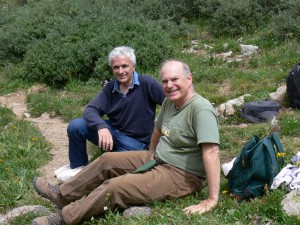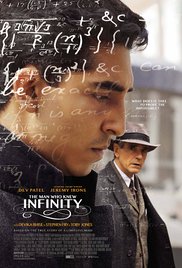Conversation with Michael Green, FRS, Professor in the Department of Applied Mathematics and Theoretical Physics and a fellow in Clare Hall, University of Cambridge.
Interview by Maria Shtilmark

You are a theoretical physicist, but the topic of the Simons Center workshop you spoke at was “Automorphic Forms, Mock Modular Forms and String Theory” (Aug 29-Sept 2, 2016) which sounds, at least to me, more like abstract mathematics. How did you become interested in aspects of number theory?
Well, my interest in certain aspects of number theory has come as a surprise to me. My background is in physics. I studied for my PhD in the Physics Department in Cambridge, and my initial interests in string theory were very much related to experimental physics of the strong interactions, which is where string theory originated. At that time I viewed my mathematical training as a tool for helping to advance the physics that I was interested in. In those days, it would have seemed unlikely that I might talk to mathematicians, let alone take part in mathematical conferences. But over the years, as string theory developed, not only have I come to a greater appreciation of mathematics as a tool in understanding theoretical physics, string theory in particular, – I’ve also come to appreciate why mathematicians do what they do. It’s always been a puzzle as to why the laws of physics can be reduced to elegant mathematical statements — as famously emphasized by Eugene Wigner, who called this the “unreasonable effectiveness of mathematics.” In recent years, as I have edged closer to the math community, I’ve been able to get a deeper sense of the elegance and the beauty of mathematics for its own sake. However, the language used by mathematicians is quite tough for a physicist to master, and it has been important for me that certain mathematicians are able to adapt their style in order to communicate with theoretical physicists. Of course, there are also certain theoretical physicists who have a natural ability to communicate in either of these two cultures.
String theory has evolved in spectacular ways, and now touches many areas that were not part of its initial purpose. And several of these diverse areas have deep connections with developing areas of mathematics, which is one of the reasons why the theory is so fascinating. So, my interest in string theory has followed a path that makes it impossible not to be interested in the kind of mathematics that is going on in this workshop, which is intrinsic to the structure of string theory in several ways.
Having just spoken of the spectacular evolution of string theory, could you comment on how modern theoretical physics compares with the pre-war period, when it was more converged, unified? Is it harder for a present day researcher to grasp all areas of theoretical physics?
It is of course extremely difficult to imagine what theoretical physics was like in the period before or just after the Second World War. Just in terms of the sheer number of people in the subject, it is a hugely bigger and more diverse field. Many subfields of theoretical physics have evolved into major fields in their own right. Recently, in the process of reviewing Dirac’s achievements, I studied some literature about what kind of physics was going on at the turn of the 20th century. Most of the research of that period has long been forgotten. The major advances in that era—the beginnings of particle physics, quantum mechanics, special and general relativity—were not only astonishing, but they involved a relatively small number of researchers. And now, of course, that is no longer true. It is impossible for any one person to follow the advances in all areas of theoretical physics. In many senses, research is a more communal activity.
One of the impressive things about string theory over the last 20 years is the way it has come to be viewed not so much as a theory of particle physics, which is where it started, but as a theoretical umbrella which contains the mathematical ideas needed to attack a very wide variety of problems in theoretical physics. So, there are people who call themselves string theorists, but who are attacking problems ranging from nitty-gritty condensed matter physics to early universe cosmology. Although many of these ideas are very speculative, it is imaginative speculation motivated by the rich structure of the theory. A key aspect of this structure involves symmetries, known as dualities, which relate apparently very different descriptions of the same system. The most powerful example of such dualities is the so-called “gauge-gravity correspondence.” This is a deep property of quantum gravity that identifies a theory of gravitational forces, which is described by string theory in a certain volume of D-dimensional space, with a non-gravitational theory on the (D-1) dimensional boundary of that volume. This has suggested the possibility that some aspects of condensed matter systems, which are described by non-gravitational forces in three space dimensions, might be described in terms of properties of gravity in one higher dimension. Conversely, puzzling aspects of string theory, or quantum gravity, may be explained in terms of properties of the boundary non-gravitational theory. This idea has opened up a whole range of possible interconnections between what we would normally think as very different disciplines.
It is intriguing that the same mathematical structure describes such different-looking physical systems. For example, a system of condensed matter at finite temperature is described within this holographic framework in terms of a black hole in an extra dimension, with the temperature identified with the temperature of Hawking radiation.
However, I don’t think that anyone really believes that when you are measuring the viscosity of a hot liquid you are looking at a black hole in higher dimensions. One should distinguish a real physical system from the mathematical framework that is used to describe it.
This evolution of string theory into a theoretical structure within which a wide variety of physical systems may be described has significantly broadened its scope. I sometimes think of an analogy with what was happening shortly after quantum mechanics was finally formulated in the 1920s. That was a dramatic breakthrough in fundamental physics, which had immediate applications to atomic physics. However, the subsequent development of quantum field theory had an even bigger impact. This involved the idea of quantizing the electro-magnetic and the electron fields. Although quantum field theory was invented as an explanation of quantum electrodynamics, it was not understood well enough to calculate any of its consequences for a long time. However, it quickly became a hugely successful tool for calculations in other areas of physics, such as condensed matter physics. Feynman diagrams, which came along later, became standard tools in quantum field theory that are useful for studying particle physics, but also a wide range of other physical phenomena. I like to think of this as an analogy to what string theory might do. String theory has a close relationship to quantum field theory — indeed in some sense it encompasses all interesting quantum field theories. From this viewpoint it is an overarching structure within which a range of interesting physical systems may be described.
Another series of recent developments in understanding the structure of string theory involve a reexamination of the role of quantum entanglement, which is a fundamental property of quantum mechanics that distinguishes it from classical physics. There are strong indications that this is at the heart of the black hole information paradox and may be an essential ingredient in understanding how space-time emerges from a more fundamental formulation of the theory. These ideas are still quite primitive, but the aims are very ambitious.
You spoke of philosophy in physics, do you have an explanation as to why string theory causes certain controversy or denial?
Some of my colleagues are disturbed by the fact that other theoretical physicists are antagonistic towards string theory. But I think it is fine for people to argue about its merits — scientific progress always involves argument. Actually, since string “theory” is not really a theory, there is no sense in which it can simply be “wrong.” However, it could turn out that it is not a useful approach to understanding theoretical physics. It has not yet been of direct use, but indirectly it has inspired some very novel ways of thinking about problems ranging from cosmology to condensed matter physics.
If people who understand enough about string theory don’t like it – that’s fine, although from my perspective they have bad taste! My problem is with people who are antagonistic to it without understanding its structure. Sometimes you get emails from people claiming to prove that Einstein was wrong. And then you discover they don’t actually know what Einstein said even though they know he is wrong. That is also often the case with people who attack string theory. But I don’t think there is a substantial antagonism to it among those who have studied it, other than a few individuals who enjoy publicizing their views. My US colleagues seem to view this as a problem but I don’t think this affects the way academic appointments are made in the UK. I don’t feel people fail to get jobs because they work on string theory.
Is it true that your collaboration with John Schwarz started in the CERN canteen in 1979?
Yes, it started in the CERN cafeteria in 1979, which illustrates a great virtue of CERN as a meeting point for people from all over the world. We had known each other earlier, when I was a postdoc at the Institute for Advanced Study in Princeton and John was Assistant Professor at Princeton University, but in that period we didn’t interact much. In 1979 we were both in CERN for the summer, and we simply started talking about what we thought was interesting. It turned out we were both interested in the same thing, so we started to work on it – which led nowhere that first summer! But our interactions were sufficiently interesting, and we decided to get together at the Aspen Center for Physics the next summer. The following couple of years he invited me to spend some months at Caltech and one year he spent a term in London, where I was a lecturer at Queen Mary College. That was a wonderful place with a Head of Department (John Charap) who really appreciated the significance of research and made it possible for me to take leaves of absence, so I had a very flexible research schedule. In addition, the fact that both John and I were unmarried meant that we had quite flexible lifestyles, which was important in scheduling long absences from home.

Speaking of collaborations—as I understand, one reason you came to the Center was to collaborate with Erik D’Hoker?
Both Eric and I received invitations to this workshop, organized by Boris Pioline and Steve Miller (among others—M.S.), both of whom have been my recent collaborators. Steve is a number theorist from Rutgers who has been very important to me as a source of mathematical wisdom over the past few years. He is the first real mathematician that I’ve collaborated with. So, I wanted to come here because of the workshop. The possibility of continuing the project that Eric and I have been working on together with Pierre Vanhove, who is also here, made it particularly timely to be here.
What do you think of this new format for the Center, namely independent visitors?
That’s a very good development. Last week, before the workshop started, was very different from this week, as we didn’t have a full program of talks. This allowed time for more intense one-on-one interaction, which has been very fruitful. But this week is interesting in another way, as there is such a diverse collection of experts at the workshop. This includes mathematicians whose talks I can’t always understand, but several of their observations have been very useful.
Putting mathematicians and physicists in touch when they have something to say to each other can be very fruitful. However, it can fail miserably unless an effort is made to communicate across the culture barrier. It is not very useful if they are incomprehensible to each other, even if they are great mathematicians or physicists.
 Yesterday Ken Ono, who had opened the workshop, presented the recently released film “The Man Who Knew Infinity,” on which he had worked as an Associate Producer and Consultant. It was a story of Srinivasa Ramanujan, one of the greatest mathematicians of the last century. Among many achievements, he introduced mock modular forms, one of the topics of this workshop, and he is famous for his work while at Cambridge. In your opinion, how authentic was this representation, did it render the atmosphere of the place, and how has Cambridge changed?
Yesterday Ken Ono, who had opened the workshop, presented the recently released film “The Man Who Knew Infinity,” on which he had worked as an Associate Producer and Consultant. It was a story of Srinivasa Ramanujan, one of the greatest mathematicians of the last century. Among many achievements, he introduced mock modular forms, one of the topics of this workshop, and he is famous for his work while at Cambridge. In your opinion, how authentic was this representation, did it render the atmosphere of the place, and how has Cambridge changed?
I think the image of Cambridge in the early 20th century portrayed in the film is probably quite accurate — the formality of the place, and the all-male nature and mild racism. I don’t know that much about Hardy and Littlewood, but their lives in Trinity College evidently had some weird aspects. They were both bachelors who lived in the College, but communicated largely by sending letters to each other. Hardy would write a letter and a servant would come and pick it up and take it to Littlewood, living practically next door! That’s what you might call old-fashioned.
Cambridge has changed hugely since the days of Ramanujan. For a start, in Ramanujan’s time Trinity College was a male enclave, whereas now it has as many women as men. Until the early 1970s only three out of about thirty colleges were women’s colleges, so when I was a student men outnumbered women by about nine to one.
The film was a very worthy attempt to portray something which is almost impossible to explain to non-mathematicians – to try and give the public some insight to why mathematics is such an amazing subject. It was much better than several other recent films with scientific themes.
Thank you very much for your time, and hope to see you again soon at the Simons Center!
Yes, and in conclusion I would like to thank the Simons Center for providing such an ideal environment for meeting with other researchers in fields related to my own, but who I would not normally get a chance to meet.
August 31, 2016


